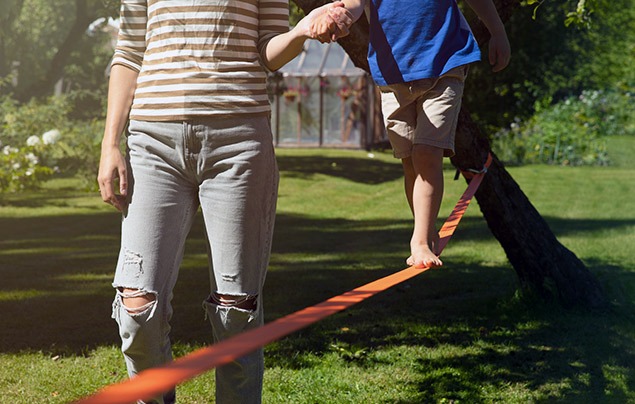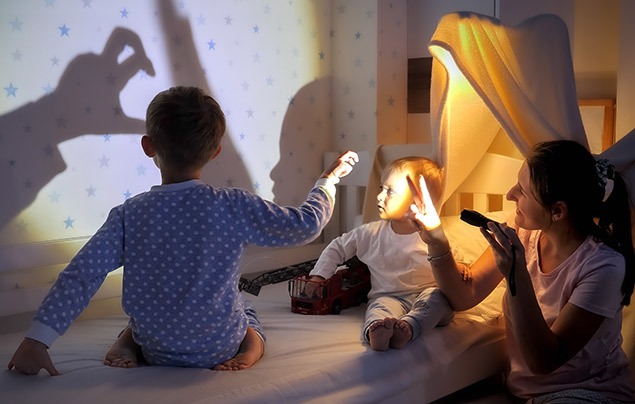Scary fun: why kids should play in the dark
Night games can liven things up – and may even boost mental health.
Have your family ever played night games? Having fun in the dark can be a great way to take advantage of warm summer evenings or long winter nights while also mixing up routines – as many of us desperately need.
Plus, playing with the lights out can feel a bit risky, and that’s a good thing for kids. Do it outside, and you might bolster their mental health, too.
The benefits of night games
Over the last several decades, kids have become less independent, says Abigail Marsh, professor of psychology and neuroscience at Georgetown University and author of The Fear Factor. For example, a study found that in 1971, 55% of British kids under 10 were allowed to walk alone to places other than school, while that number shrunk to nearly zero by 2010 – a percentage that Marsh confirms is likely similar today.
And that’s a problem. “Kids are built to seek out novel, challenging experiences because that’s how they learn,” she says. And without taking appropriate risks – like walking by themselves through a neighbourhood or trying out activities that might seem scary at first – many psychologists worry that kids won’t be able to take on the bigger risks that come with adulthood. “You cannot learn how to do this from a book,” Marsh says.
But parents can help kids build these skills. “Playing in the dark is such a good example of something that kids are afraid of,” she says. “And parents’ job is to scaffold those experiences for their children. Help them contextualise it, help them think about the risk, and make it fun. Teach children that they are able to do more than they think they can.”
For some kids, doing things that are mildly risky or scary can be especially helpful in their chaotic lives, says Ashley Zucker, a child, adolescent and general psychiatrist at Kaiser Permante in Fontana, California.
“Overcoming challenges can lead to an increased sense of independence, bravery and problem-solving ability – which in a world of chaos can create a lot of safety and a sense of accomplishment for children,” she says.
What happens to your brain in the dark
“For most kids, the dark is a scary place,” Zucker says. “It blocks out other distractions and stimuli in our environment.” So, when the lights go out, imaginations can run wild.
And when anxiety ratchets up, the brain adjusts how it manages stimulus. “The regions of our brain that control our visual and auditory senses become more active,” Zucker says. That means every gust of wind or creaky floorboard is louder; every shadow is more pronounced.
It’s pretty easy to trigger young kids’ fear response, because the amygdala, which regulates the feeling of being scared, is highly developed at birth. But as they move through early childhood into the tween years, the brain changes. “The connections between the amygdala and the frontal cortex, which is involved in regulating emotion, are getting wired up during that time period,” Marsh says. That means they’re better able to manage their responses to scary things.
So, as the brain develops, playing in the dark can feel a lot less scary – and even ride that line between frightening and fun. “It’s very good at varying our responses to threat based on the proximity and seriousness of the threat,” Marsh says. “So when you’re dealing with a threat that’s unlikely to be really dangerous or sort of ambiguous, you’ll get a smaller response from the amygdala.”
But that response can still feel good, especially when we’re seeking out the feeling of fear, like during a game of hide-and-seek in the dark.
“We’re scared before anything has even happened,” Zucker says. “The greater the build-up of suspense or anticipation, the greater the release when that fear has resolved.” After a welcome fright, cortisol and adrenaline spike, and endorphins and dopamine swirl through circuits in our bodies. All that creates pleasant feelings, Marsh says.
8 ideas for night games
Parents can test out different types of play in the dark to see which are a match for the age and fear-tolerance of their kids. “If your kids have structure, they feel a little more safe,” says Rebecca Young, a teacher and experienced torch-light tag facilitator.
Setting physical boundaries is crucial, she says, like rules about how far kids can run or where they can hide. For older kids, Young says games tied to scary stories or urban legends can create age-appropriate fun.
Here are eight night game ideas to get you started…
Torchlight tag
One person is “it” and shines the light of the torch on other players to ‘tag’ them “out”.
If it’s safe to do so, make the game more interesting by having the other players crawl along the floor or hide behind trees to stay out of sight as they move from one base to another.
You could also modify the game so that all players have torches and the person who’s “it” must touch a player to get them out.
Shadow puppets
Use a torch to make shapes with hands or cut-outs and project the shadows against the wall. Tell stories about the shapes – funny or creepy – depending on the kids’ ages.
Ghost in the graveyard
The “ghost” runs off to hide. When someone finds the ghost, they yell “Ghost in the graveyard!” The ghost tries to tag the remaining players as the run back to base. Whomever is tagged becomes the ghost.
Glow-in-the-dark games
Use glow-in-the-dark paint, pens, stickers or glow-sticks to play simple games like hop-scotch, hula hoops, limbo, scavenger hunt or bowling in the dark. For a more sustainable option, use dim lamps or fairy lights to create a fun atmosphere.
Tapping hide-and-seek
Hiding players tap two objects together every 60 seconds and the seeker uses the sounds to locate them. Hiders can change locations throughout the game.
Looking for more fun family activity ideas? Sign up to the Nat Geo Kids Family Round-Up newsletter for free articles, good news, games and more in your inbox every week.
Disco in the dark
This one’s pretty self-explanatory – turn out all the lights, play fun music, and dance! Add in a disco ball, glow sticks or fairy lights for more fun.
Secret messages
Find a guide to Morse code (here’s an example) then race to see who can decode a pre-created message first.
Torch limbo
Ditch the stick and use the beam from a torch instead. Players must shimmy under the line of light without breaking it.


















LEAVE A COMMENT
THANK YOU
Your comment will be checked and approved shortly.
WELL DONE,
YOUR COMMENT
HAS BEEN ADDED!
COMMENTS1
CUSTOMIZE YOUR AVATAR